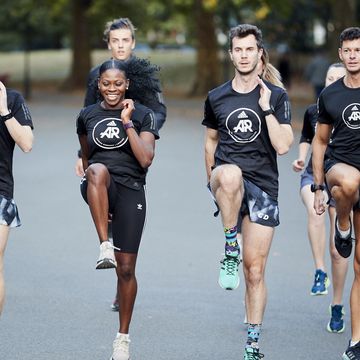So you’ve completed your first 5K, parkrun or Couch to 5K plan and are looking for a new challenge. We’re here to help you take the next step. Read on for all the dos, don’ts and top tips to set you safely on your way to achieving that first 10K.
What everyone's reading
Are you ready to run 10K?
There’s a reason why stepping up from 5km to 10km is such a popular target for runners. It’s challenging yet achievable goal and, unlikey training for a marathonor ultra, training for it won’t competely take over your life. What’s more, having goals and targets can keep us motivated, driving us to challenge ourselves while continuing healthy patterns and routines that we have built up. Increasing the distance from 5K to 10K can seem daunting and leave us, understandably, with doubts, making us question can I really double the distance? And in what time frame
The good news is that the hardest part is done. Though you might have only run 5K, in many ways you’re already over halfway there. Why? Because starting from scratch and building up to your first 5K is a physical and psychological challenge in itself, and you’ve done it. You have that foundation in place that will make that additional 5K easier than you may think. Having a sensible, realistic plan in place should make going from 5K to 10K a little more manageable than going from zero to 5K.
Still, to achieve this goal it’s important to be realistic. So start by asking yourself some questions: is this the right time? Is my body ready for that distance? What are the other stresses in my life? Why do I want to take on this challenge? Before you throw yourself headfirst into a new plan, it’s worth doing a bit of a self-reflection and MOT on yourself and what life looks like for you over the coming weeks to help you decide if now is the right time; judge the following from 1 to 5:
How settled is my home and work life over the next few weeks?
1 = Stress, clutter and chaos
5 = Serenity itself
Is my body feeling pain and niggle-free?
1 = I'm creaking!
5 = Fresh as a daisy
How did I cope on my 5K training journey?
1 = To be honest, it was a slog
5 = Itching to do more
What is my available training time?
1 = Limited
5 = Free as a bird
How to go from 5K to 10K
Progressing in distance isn’t the only graduation you can make from your first 5K. You can of course choose to consolidate for a period of time. Alternatively, you could consider focusing on getting faster at 5K as opposed to extending to 10K– a great challenge for runners of all abilities. Have a look at your scores above. What are your scores?
If you’re seeing 1s and 2s, consider giving yourself a bit longer with your current training, and target another 5K race or parkrun over the coming weeks. Ultimately, if you stay consistent doing what you are doing, you are likely to continue to get fitter.
However, if you’re scoring 4s and 5s, read on for my top tips on extending your endurance and tackling your first 10K.
A 5K to 10K plan
The exciting endeavour of increasing from 5K to 10K requires dedication, patience and, most importantly, a well-structured, balanced training plan. We dive into some top tips to help you reach this impressive milestone.
Set a timeframe: The time scale for progression will be different for everyone and depends on many factors individual to each runner. Consider your journey from zero to 5K and give yourself enough time to build your 10km pace. For some, four weeks will be enough; for others, it could be an 8-10 week process.
Try this: Check out our four-week plan below. If you feel you are not ready to start this sort of work, give yourself a few more weeks to build into it.
Sign up: When it comes to getting yourself motivated, there’s no substitute for booking a specific race that puts your hard work into practice. As well as being given a nice medal, races will give you the opportunity to run with others – something that many find motivating – and potentially follow a pacer. Just be sure to choose a well-organised race with a course that suits your abilities.
Try this: Pick a race which is a similar profile to your regular running routes… for now.
Add variety: While going from zero to 5K is chiefly about delvoping rnning ability through easy-paced running, increasing from 5K to 10K requires a slightly different focus: developing distance and time through pace variations. This helps to push your fitness and progress you further.
Try this: Options for increasing intensity are endless. Try some of the simple sessions below or simply a run where you aim to mix paces between 2/10 and 8/10 for short bursts of 30-90 seconds – known commonly as ‘fartlek’.
How can Fartlek help you get faster?
Easy does it: While variety is important, easy running should still form the bedrock of your 10K training. So while it may be tempting to train at higher intensities, it is important to incorporate some steady, controlled, easy pace runs into your plan.
Try this: While some higher-intensity sessions can be useful, these shouldn’t push you beyond 7-8/10 effort very often. Sustainable controlled work is the key to 10km success.
Everything you need to know about easy miles
Be consistent: Day-to-day consistent accumulation of running is more important than any session, long run or cross-training you might do. So make getting out to run regularly your number one priority.
Try this: Before you start, shortlist the top 3-5 things that hold back your consistency. Is it the time of day you plan to run? Your nutrition and energy levels? Trying to run too hard? Then make a plan to address these.
Everything you need to know about nutrition
Time on feet: Doubling the distance will require a gradual increase in time spent on feet. This is non-negotiable if you are aiming to achieve that 10K distance. Don’t worry, this is easy to do as long as your sensible and manage your training load effectively. Concentrate on establishing a sustainable routine that doesn’t leave you overly sore and fatigued the next day. In reality, this will mean lots of easy-paced running and just a little of the high-intensity stuff.
Try this: Build your frequency first. For most people, it will be better to do 4 x 30-minute runs than one long run and one interval session a week. Think: frequency, volume, speed – in that order.
Interval sessions to build speed
Cross training: Increasing training volume comes with an increased risk of injury, however there are some helpful methods to limit this risk. Cross training activities, such as cycling and swimming, are just as effective at progressing endurance whilst remaining low impact and reducing the risk of injury.
Try this: If you were running three times a week on your coach to 5K programme, aim to bring in one additional cross-training session a week, and then if you feel good over time an additional run.
How to cross train when injured
Introduce long runs: Incorporating longer runs into your plan can build endurance and prepare you mentally for the 10K distance. You don’t need to be out for hours; just enough to get you comfortable with enduring running for a sustained period. Remember, it is the collection and consistency of your training that will see you through.
Try this: In time, long runs for 10K can extend to 90 minutes and beyond. To tackle your first 10K, though, getting to 60 minutes with minimal breaks is a great target before the race.
Patience and dedication are required to transition from 5K to 10K. It’s important to remember that it won’t happen overnight, it’s a gradual process and one that should be enjoyed and celebrated. Good luck and happy running!














